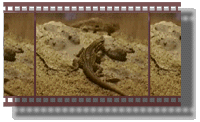CLASSES: [Bio20C: EEB Intro] [Bio140L: Field Behavioral Ecology] [Bio140: Behavioral Ecology] [Bio143: Herpetology]
OTHER: [Reprints] [Curriculum Vitae] [Lizardland] [Sinervo Home] [EEB Home]
An unusual game is being played out in the Coast Range of California.
Three alternative male strategies are locked in an ecological "perpetual
motion machine" from which there appears little escape. As in the rock-paper-scissors
game where rock beats scissors, paper beats rock, and scissors beats paper,
three morphs of lizards cycle from the ultra-dominant polygynous orange-throated
males, which best the more monogamous mate gaurding blues; the oranges are
in turn bested by the sneaker strategy of yellow-throated males, and the
sneaker strategy of yellows is in turn bested by the mate guarding strategy
of blue-throated males. Each strategy in this game has a strength and a
weakness, and there is the evolutionary rub that keeps the wheels spinning.
See the

Thus, each strategy has a strength and a weakness and there are strong assymetries in contests between morphs. Trespassing yellows, with their female mimcry, can fool oranges. However, trespassing yellows are hunted down by blue males and attacked. While oranges with their high testosterone and high stamina can handily defeat blues, they are susceptible to the charms of yellows. In contrast, contests between like morphs (e.g., blue vs blue, orange vs orange or yellow vs yellow) are usually more symmetric.
 The bobs can easily be analyzed
by digitizing images and "slicing" through the video frames to
get the outline of the lizard head bobbing up and down through time. This
has been highlighted in red. The male in this sequence is participating
in the "challenge" display. Yoni Brandt and I are busily analyzing
such videos.
The bobs can easily be analyzed
by digitizing images and "slicing" through the video frames to
get the outline of the lizard head bobbing up and down through time. This
has been highlighted in red. The male in this sequence is participating
in the "challenge" display. Yoni Brandt and I are busily analyzing
such videos.
 If you haven't already visited the
Video
Library, bobbing is best illustrated by looking at our expanding online
video library that awaits your viewing pleasure.
If you haven't already visited the
Video
Library, bobbing is best illustrated by looking at our expanding online
video library that awaits your viewing pleasure.
CLASSES: [Bio20C: EEB Intro] [Bio140L: Field Behavioral Ecology] [Bio140: Behavioral Ecology] [Bio143: Herpetology]
OTHER: [Reprints] [Curriculum Vitae] [Lizardland] [Sinervo Home] [EEB Home]
This page last updated 2/20/01sinervo@biology.ucsc.edu